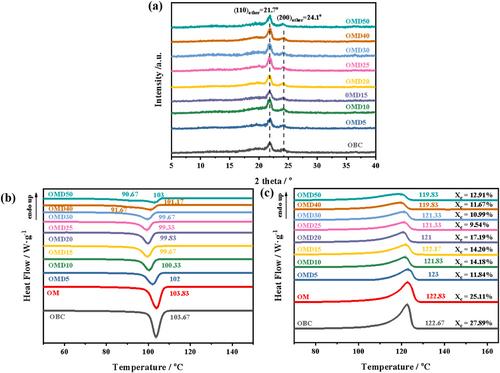Yu Kou, Yuqi Ma, Jialiang Li, Shilong Zhang, Jiaxun Cao, Hua Deng, Yanling Zhu, Yongsheng Zhao, Jianbin Qin, Guangcheng Zhang
求助PDF
{"title":"将马来酸酐反应性熔融接枝到烯烃嵌段共聚物 (OBC) 上,形成高性能极性聚烯烃热塑性弹性体","authors":"Yu Kou, Yuqi Ma, Jialiang Li, Shilong Zhang, Jiaxun Cao, Hua Deng, Yanling Zhu, Yongsheng Zhao, Jianbin Qin, Guangcheng Zhang","doi":"10.1002/pi.6627","DOIUrl":null,"url":null,"abstract":"<p>The block structure of olefin block copolymer (OBC) elastomer gives it good elasticity and heat resistance relative to other polyolefin elastomers. However, the non-polar nature of OBC chains limits its comprehensive properties like dyeing and toughening for polar engineering plastics. In this work, maleic anhydride (MA) and dicumyl peroxide (DCP) were selected as a typical polar monomer and a radical initiator to modify the polarity of OBC elastomer. During the melt-grafting process, the DCP content was tuned to optimize the grafting efficiency while the MA-to-OBC ratio was fixed at 5 wt%. It was found that all the melt-grafting reactions show high efficiency and can be finished in 3 min at 170 °C. With the increase of DCP content, the estimated grafting degree of OBC-<i>g</i>-MA elastomer increases from 0.40% to 1.16% along with increased gel content from 4.27% to 22.44%. A suitable grafting process was obtained with a DCP content of 3.0 wt% by balancing grafting efficiency and final mechanical properties. The optimized OBC-<i>g</i>-MA elastomer with a grafting degree of 0.92% has a mechanical strength of 17.15 MPa, a Young's modulus of 26.35 MPa, elongation of 1564% and strain recovery of 59.73%. Additionally, the contact angle test shows that polar grafting can increase surface hydrophilicity while excessive crosslinking promotes hydrophobicity. Therefore, our work has demonstrated the feasibility of the reactive melt-grafting method to prepare OBC-<i>g</i>-MA elastomer and can also provide a processing reference for other chemical functionalization of polyolefin thermoplastic elastomers. © 2024 Society of Industrial Chemistry.</p>","PeriodicalId":20404,"journal":{"name":"Polymer International","volume":"73 7","pages":"545-555"},"PeriodicalIF":2.9000,"publicationDate":"2024-03-05","publicationTypes":"Journal Article","fieldsOfStudy":null,"isOpenAccess":false,"openAccessPdf":"","citationCount":"0","resultStr":"{\"title\":\"Reactive melt-grafting of maleic anhydride onto olefin block copolymer toward high-performance polar polyolefin thermoplastic elastomer\",\"authors\":\"Yu Kou, Yuqi Ma, Jialiang Li, Shilong Zhang, Jiaxun Cao, Hua Deng, Yanling Zhu, Yongsheng Zhao, Jianbin Qin, Guangcheng Zhang\",\"doi\":\"10.1002/pi.6627\",\"DOIUrl\":null,\"url\":null,\"abstract\":\"<p>The block structure of olefin block copolymer (OBC) elastomer gives it good elasticity and heat resistance relative to other polyolefin elastomers. However, the non-polar nature of OBC chains limits its comprehensive properties like dyeing and toughening for polar engineering plastics. In this work, maleic anhydride (MA) and dicumyl peroxide (DCP) were selected as a typical polar monomer and a radical initiator to modify the polarity of OBC elastomer. During the melt-grafting process, the DCP content was tuned to optimize the grafting efficiency while the MA-to-OBC ratio was fixed at 5 wt%. It was found that all the melt-grafting reactions show high efficiency and can be finished in 3 min at 170 °C. With the increase of DCP content, the estimated grafting degree of OBC-<i>g</i>-MA elastomer increases from 0.40% to 1.16% along with increased gel content from 4.27% to 22.44%. A suitable grafting process was obtained with a DCP content of 3.0 wt% by balancing grafting efficiency and final mechanical properties. The optimized OBC-<i>g</i>-MA elastomer with a grafting degree of 0.92% has a mechanical strength of 17.15 MPa, a Young's modulus of 26.35 MPa, elongation of 1564% and strain recovery of 59.73%. Additionally, the contact angle test shows that polar grafting can increase surface hydrophilicity while excessive crosslinking promotes hydrophobicity. Therefore, our work has demonstrated the feasibility of the reactive melt-grafting method to prepare OBC-<i>g</i>-MA elastomer and can also provide a processing reference for other chemical functionalization of polyolefin thermoplastic elastomers. © 2024 Society of Industrial Chemistry.</p>\",\"PeriodicalId\":20404,\"journal\":{\"name\":\"Polymer International\",\"volume\":\"73 7\",\"pages\":\"545-555\"},\"PeriodicalIF\":2.9000,\"publicationDate\":\"2024-03-05\",\"publicationTypes\":\"Journal Article\",\"fieldsOfStudy\":null,\"isOpenAccess\":false,\"openAccessPdf\":\"\",\"citationCount\":\"0\",\"resultStr\":null,\"platform\":\"Semanticscholar\",\"paperid\":null,\"PeriodicalName\":\"Polymer International\",\"FirstCategoryId\":\"92\",\"ListUrlMain\":\"https://onlinelibrary.wiley.com/doi/10.1002/pi.6627\",\"RegionNum\":4,\"RegionCategory\":\"化学\",\"ArticlePicture\":[],\"TitleCN\":null,\"AbstractTextCN\":null,\"PMCID\":null,\"EPubDate\":\"\",\"PubModel\":\"\",\"JCR\":\"Q2\",\"JCRName\":\"POLYMER SCIENCE\",\"Score\":null,\"Total\":0}","platform":"Semanticscholar","paperid":null,"PeriodicalName":"Polymer International","FirstCategoryId":"92","ListUrlMain":"https://onlinelibrary.wiley.com/doi/10.1002/pi.6627","RegionNum":4,"RegionCategory":"化学","ArticlePicture":[],"TitleCN":null,"AbstractTextCN":null,"PMCID":null,"EPubDate":"","PubModel":"","JCR":"Q2","JCRName":"POLYMER SCIENCE","Score":null,"Total":0}
引用次数: 0
引用
批量引用


 求助内容:
求助内容: 应助结果提醒方式:
应助结果提醒方式:


